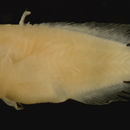pt-BR
nomes no trilho de navegação


Diagnosis: Reduced spinous dorsal fin with only 2-4 dorsal-fin spines and no obvious anal-fin spines indicates the soapfishes of Rypticus. There are six regional species with broadly overlapping fin-ray counts. They can be separated somewhat by the number of dorsal-fin spines: R. saponaceus and R. randalli have 3 dorsal-fin spines, R. subbifrenatus has 3 or 4 dorsal-fin spines, and the remaining species have only two dorsal-fin spines: the widespread R. bistrispinus and R. bornoi (= R. macrostigmus) and R. maculatus from US waters and the GOM only.
Description: Body thick and moderately wide with a medium round eye and large terminal mouth. Pectoral-fin rays very long, reaching well past the vent, pelvic fins short, dorsal-fin base long and anal-fin base medium length, caudal peduncle relatively narrow and short. First dorsal-fin spine prominent and covered in soft tissue, subsequent spines very short. Fins generally covered in soft tissue membranes. Very few melanophores, typically only along the pectoral-fin rays.
Rypticus is a genus of marine ray-finned fish, related to the groupers and classified within the subfamily Epinephelinae of the family Serranidae. It is one of several genera of soapfishes. These fish live in the Atlantic and eastern Pacific Oceans in tropical and warmer temperate zones.[3]
The genus can be distinguished from the rest of the Serranidae by a few morphological details, such as its lack of anal fin spines. It also has only two to four dorsal fin spines; other serranids have more. The mouth is large and the lower jaw protrudes. The coloration varies, but usually a brown stripe runs from the mouth to the front of the dorsal fin. Several species are distinctly spotted. R. bistrispinus has red-brown spots, R. bornoi and R. subbifrenatus have dark brown, rounded spots, R. maculatus has white spots, R. bicolor and R. courtenayi have many rounded, pale cream spots, and R. nigripinnis has ocellated (eye-like) spots, while R. randalli is more blotchy than spotted.[3]
Like many other soapfishes, Rysticus species secrete large amounts of toxic mucus from their skin in response to stress. The toxin, grammistin, repels predators.[3]
Rypticus species are nocturnal, feeding at night on crustaceans, molluscs, and fish.[3]
These fish are protogynous hermaphrodites, with females able to change sex to male. This is not uncommon among the serranids. Rypticus is unique, though, in that a fish has both male and female reproductive tissues which are separate on the cellular level, but are wrapped around each other in the gonad.[3]
Most species live around islands and along the continental shelves. R. nigripinnis and R. randalli can tolerate lower salinities than many serranids, and they are known to inhabit estuaries.[3]
Ten species in this genus are known.[4][5] The latest, R. carpenteri, was described in 2012.[6]
Species include:
R. courtenayi has the narrowest distribution, being endemic to the Revillagigedo Islands of Mexico. Its range is only about 25 km2. It is listed as a vulnerable species by the IUCN.[7]
Rypticus is a genus of marine ray-finned fish, related to the groupers and classified within the subfamily Epinephelinae of the family Serranidae. It is one of several genera of soapfishes. These fish live in the Atlantic and eastern Pacific Oceans in tropical and warmer temperate zones.
Rypticus è un genere di pesci ossei marini appartenente alla famiglia Serranidae.
Le specie sono presenti prevalentemente nell'Oceano Atlantico occidentale tropicale compreso il mar dei Caraibi, alcune specie vivono nei mari caldi dell'Oceano Pacifico orientale e una specie R. saponaceus vive lungo le coste africane dell'Atlantico orientale. Sono pesci costieri presenti spesso nelle vicinanze delle barriere coralline[1].
Rypticus è un genere di pesci ossei marini appartenente alla famiglia Serranidae.
Rypticus is een geslacht van straalvinnige vissen uit de familie van zaag- of zeebaarzen (Serranidae).[1] Het geslacht is voor het eerst wetenschappelijk beschreven in 1829 door Cuvier & Valenciennes.
Rypticus is een geslacht van straalvinnige vissen uit de familie van zaag- of zeebaarzen (Serranidae). Het geslacht is voor het eerst wetenschappelijk beschreven in 1829 door Cuvier & Valenciennes.
Rypticus - rodzaj ryb okoniokształtnych z rodziny strzępielowatych.
Gatunki zaliczane do tego rodzaju [2]:
Rypticus - rodzaj ryb okoniokształtnych z rodziny strzępielowatych.